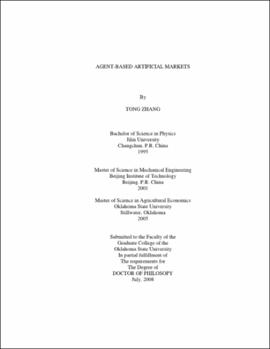| dc.contributor.advisor | Brorsen, B. Wade | |
| dc.contributor.author | Zhang, Tong | |
| dc.date.accessioned | 2013-11-26T08:22:07Z | |
| dc.date.available | 2013-11-26T08:22:07Z | |
| dc.date.issued | 2008-07 | |
| dc.identifier.uri | https://hdl.handle.net/11244/6549 | |
| dc.description.abstract | Scope and Method of Study: This study is composed of three essays. The first essay adapts the particle swarm optimization algorithm (PSO) to find the equilibrium in an agent-based artificial market. The simulated agents follow simple behavioral rules. The PSO algorithm is compared to a genetic algorithm (GA) under a Cournot game. The second essay uses the agent-based model with PSO algorithm to find equilibrium in a price-quantity competition game. In this game, agents purchase products from sellers and sell processed goods to the retail market using both bid price and capacity as their strategies. Simulations consider different numbers of buyers and are performed with and without a capacity cost. The third essay uses an agent-based model to estimate the impact of captive supplies on the spot market price under long run and short run assumptions in fed cattle markets. Packers purchase cattle from feeders both under captive supply contracts and in the spot market. Captive contracts are assumed fixed in the short run and flexible in the long run. Packers have one choice variable, procurement quantity in the spot market, in the short run; and have an additional choice variable, number of captive contracts in the long run. | |
| dc.description.abstract | Findings and Conclusions: The first essay successfully adapts the PSO algorithm to solve dynamic economic games. PSO gives faster convergence and more precise answers than the genetic GA methods used by some previous economic studies. The agent-based model is new to agricultural economics and suitable to study complex economic problems that are hard to solve with mathematical methods. The simulation results of the second essay show that the agent-based model can explain the collusion and competition phenomena observed in previous experimental studies with human subjects which cannot be explained by theories. Under price-quantity competition, prices with one or two firms are at the monopsony level and with four firms prices are always at the perfectly competitive level; but the triopsony market changes from mostly monopsony to perfect competition when capacity cost increases from zero to a higher level. The third essay shows that the price depressing effect of captive supplies found in previous theoretical work is a short run effect and in the long run this phenomenon disappears. | |
| dc.format | application/pdf | |
| dc.language | en_US | |
| dc.rights | Copyright is held by the author who has granted the Oklahoma State University Library the non-exclusive right to share this material in its institutional repository. Contact Digital Library Services at lib-dls@okstate.edu or 405-744-9161 for the permission policy on the use, reproduction or distribution of this material. | |
| dc.title | Agent-based artificial markets | |
| dc.contributor.committeeMember | Fain, James R. | |
| dc.contributor.committeeMember | Lusk, Jayson L. | |
| dc.contributor.committeeMember | Ward, Clement E. | |
| osu.filename | Zhang_okstate_0664D_10572.pdf | |
| osu.accesstype | Open Access | |
| dc.type.genre | Dissertation | |
| dc.type.material | Text | |
| dc.subject.keywords | agent-based model | |
| dc.subject.keywords | captive supply | |
| dc.subject.keywords | cournot game | |
| dc.subject.keywords | particle swarm optimization | |
| dc.subject.keywords | quantity-price strategic decision | |
| thesis.degree.discipline | Agricultural Economics | |
| thesis.degree.grantor | Oklahoma State University | |
